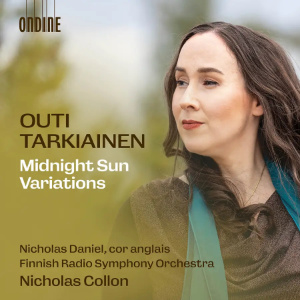
Outi Tarkiainen (b. 1985)
Midnight Sun Variations (2019)
Songs of the Ice (2019)
Milky Ways (2022)
The Ring of Fire and Love (2020)
Nicholas Daniel (cor anglais, Milky Ways)
Finnish Radio Symphony Orchestra/Nicholas Collon
rec. 2023, Helsinki Music Centre, Finland
Ondine ODE 1432-2 [55]
Outi Tarkiainen studied at the Sibelius Academy with Veli-Matti Puumala and Eero Hämeenniemi, and then at the Guildhall School of Music in London. She belongs to a generation of Finnish composers now steadily acquiring well-deserved worldwide reputation. She was born in the north of Finland, and that matters. She feels strongly connected to those remote regions, and she feels the importance of nature for the Sámi people. Her beautiful, substantial song cycle The Earth, Spring’s Daughter from 2014/2015 is clearly inspired by the Sámi culture. (It has been recorded on Ondine ODE 1353-2.) Her music often reflects her concern with nature and the environment, and her motherhood – as in the four works recorded here.
Midnight Sun Variations and Songs of the Ice may be performed separately or as a diptych of sorts, in either order. The first title may be misleading, since this is not a theme with variations, but an orchestral tone poem – for lack of a better description. The piece is inspired by light and its varying densities, and its absence during the long midnight sun season in the North. Antti Häyrynen rightly observes in his insert notes that the “natural environment of the North is considered bleak and barren, but closer inspection reveals a vast richness and range of colours”. That is exactly what there is in Tarkiainen’s subtly varied orchestral palette, from lightly shimmering textures to menacing growling in the bass register. Sibelius’s shadow hovers large over some episodes in this beautiful work. One senses that Tarkiainen’s music shares the roots and soil with Sibelius’s final masterpiece Tapiola.
The sibling work, Songs of the Ice, also suggests natural phenomena. The notes say that “the music stems from natural phenomena in the Arctic region and reminds us that humans are only part of the cycle of nature and belong to nature”. Indeed, while ice can seem permanent or motionless, it moves constantly according to the seasons, and the climate change has further effect. The music has much in common with that of Midnight Sun Variations, and is again wonderfully and subtly written for large orchestra. It hints at a wide range of moods and emotions, but eschews any straight description.
Nature and the natural cycle of life are also reflected in Milky Ways, a concerto for cor anglais and orchestra. The title may again suggest ideas to have triggered the composer’s imagination: perhaps the Milky Way of which the Earth is just a tiny particle, or more literally breastfeeding and the mother-child connection. The first movement, The Infant Gaze, moves along in predominantly slow tempi, interrupted by short outbursts of energy, but eventually returns to the initial contemplative mood. The second movement, Interplays, “is about the evolution of the relationship of child and mother”. It is a scherzo, brilliant, animated and at times capricious. The final movement, At the Fountainhead of God, reverts to the general peaceful mood of the first movement. The music here is all harmonious slow tempi, soaring melodies for the soloist and shimmering orchestral textures, before slowly and calmly fading away. This yet another very fine piece of music and a superb addition to the somewhat limited repertoire for the cor anglais. Nicholas Daniel wonderfully and effortlessly realises the solo part, with musicality and immaculate artistry.
The Ring of Fire and Love takes its basic ideas from the Far East, but again this is not programmatic music. The Ring of Fire is a string of volcanoes and sites of seismic activity around the edges of the Pacific Ocean. The composer also refers to the “ring of fire” effect during an annular eclipse, when the moon covers the centre of the sun. She mentions a third meaning: it is what a woman feels when, at birth, the baby’s head passes through the pelvis. As expected, the music travels through contrasted musical landscapes, and suggests various moods and atmospheres. It is an exqusite example of the suggestive power of Tarkiainen’s music.
The four works in this release are a fine survey of Tarkiainen’s recent output. The musicians play with commitment and enthusiasm. They clearly believe in the music and serve it wholeheartedly. The recording is up to Ondine’s standard. Antti Häyrynen’s concise but relevant notes are a bonus. This is a magnificant release by all counts. If you do not know Outi Tarkiainen’s music, here is a great introduction to her beautiful and often gripping sound world.
Hubert Culot
If you purchase this recording using a link below, it generates revenue for MWI and helps us maintain free access to the site




















